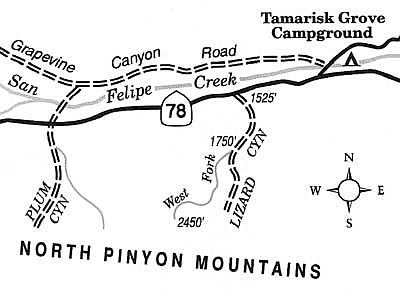 Facebook
Facebook
 X
X
 Instagram
Instagram
 TikTok
TikTok
 Youtube
Youtube
With canyons and ravines numbering in the thousands or tens of thousands, the one-thousand-square-mile Anza-Borrego Desert State Park offers a lifetime of scenic exploration. Even the smaller canyons of the park offer a variety of biological habitats: sandy washes where smoke trees periodically deal with destructive flash floods, north-facing slopes where pinyon pines and junipers take refuge from the glaring sun, and south-facing slopes where drought-resistant agave and cacti plump up to store every bit of meager runoff they can get from infrequent rains.
Lizard Canyon (a.k.a. Lizard Wash) is one such canyon, moderate in width, length, and depth compared to others in Anza-Borrego. It lies in the central part of the park, just south of Highway 78, in an area known as the North Pinyon Mountains.
A circumspectly marked unpaved road departs from Highway 78 at mile 75.9 (as reckoned by the white state highway mileage markers) and goes south along the bottom of Lizard Canyon for about a mile. That road is suitable for high-clearance vehicles, and probably disastrous for most passenger cars. So those with low-slung vehicles should park alongside Highway 78 and hike in from there.
At a point 0.7 mile into Lizard Canyon, the canyon divides. The unpaved road bends left, staying in the shallower, wider, East Fork Lizard Canyon. Abandon the road at this point (not in your car, but on foot!) and enter the more-interesting, narrower, deeper, roadless West Fork Lizard Canyon on the right.
The walking is easy as you gradually ascend the West Fork, trending south, mostly on smooth sand and sometimes over rocks. You pass soaring walls of broken, cream-colored granitic rock, and later metamorphic rock consisting of striped and banded beige and chocolate-brown layers. Small caverns pit the canyon wall on the left, where the metamorphic zone begins.
Ocotillo, two types of cholla cactus, barrel cactus, and fishhook cactus (diminutive and drab in color) dot the slopes above. The display of annual and ephemeral wildflowers here is concluding a stellar season; these plants will virtually disappear as soon as a string of hot spring days occurs. The cactus bloom, though, is probably peaking at present.
After 1.0 mile, the canyon becomes narrower and swings right (southwest then west). Hardy junipers, clinging to life at this marginally low elevation, dot the slope to the left.
Starting at 1.6 miles, the canyon swings left, trends south again, and widens. This a good area to turn around and retrace your steps back to the car -- but not before you treat yourself to a few minutes' silence. Contemplate the naked rock, the blue sky, the soft sounds of small birds flitting about, and the yammering of an unseen woodpecker tapping on an agave flower stalk.


With canyons and ravines numbering in the thousands or tens of thousands, the one-thousand-square-mile Anza-Borrego Desert State Park offers a lifetime of scenic exploration. Even the smaller canyons of the park offer a variety of biological habitats: sandy washes where smoke trees periodically deal with destructive flash floods, north-facing slopes where pinyon pines and junipers take refuge from the glaring sun, and south-facing slopes where drought-resistant agave and cacti plump up to store every bit of meager runoff they can get from infrequent rains.
Lizard Canyon (a.k.a. Lizard Wash) is one such canyon, moderate in width, length, and depth compared to others in Anza-Borrego. It lies in the central part of the park, just south of Highway 78, in an area known as the North Pinyon Mountains.
A circumspectly marked unpaved road departs from Highway 78 at mile 75.9 (as reckoned by the white state highway mileage markers) and goes south along the bottom of Lizard Canyon for about a mile. That road is suitable for high-clearance vehicles, and probably disastrous for most passenger cars. So those with low-slung vehicles should park alongside Highway 78 and hike in from there.
At a point 0.7 mile into Lizard Canyon, the canyon divides. The unpaved road bends left, staying in the shallower, wider, East Fork Lizard Canyon. Abandon the road at this point (not in your car, but on foot!) and enter the more-interesting, narrower, deeper, roadless West Fork Lizard Canyon on the right.
The walking is easy as you gradually ascend the West Fork, trending south, mostly on smooth sand and sometimes over rocks. You pass soaring walls of broken, cream-colored granitic rock, and later metamorphic rock consisting of striped and banded beige and chocolate-brown layers. Small caverns pit the canyon wall on the left, where the metamorphic zone begins.
Ocotillo, two types of cholla cactus, barrel cactus, and fishhook cactus (diminutive and drab in color) dot the slopes above. The display of annual and ephemeral wildflowers here is concluding a stellar season; these plants will virtually disappear as soon as a string of hot spring days occurs. The cactus bloom, though, is probably peaking at present.
After 1.0 mile, the canyon becomes narrower and swings right (southwest then west). Hardy junipers, clinging to life at this marginally low elevation, dot the slope to the left.
Starting at 1.6 miles, the canyon swings left, trends south again, and widens. This a good area to turn around and retrace your steps back to the car -- but not before you treat yourself to a few minutes' silence. Contemplate the naked rock, the blue sky, the soft sounds of small birds flitting about, and the yammering of an unseen woodpecker tapping on an agave flower stalk.
